-
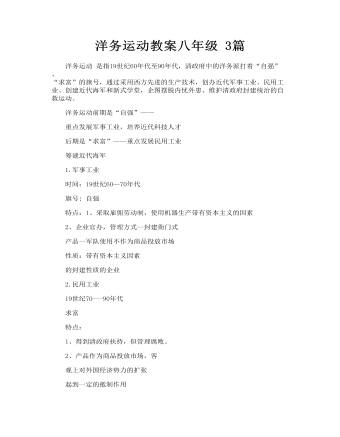
洋务运动教案八年级 3篇
1.军事工业 时间:19世纪60—70年代 旗号: 自强 特点:1、采取雇佣劳动制,使用机器生产带有资本主义的因素 2、企业官办,管理方式--封建衙门式 产品--军队使用不作为商品投放市场 性质:带有资本主义因素 的封建性质的企业
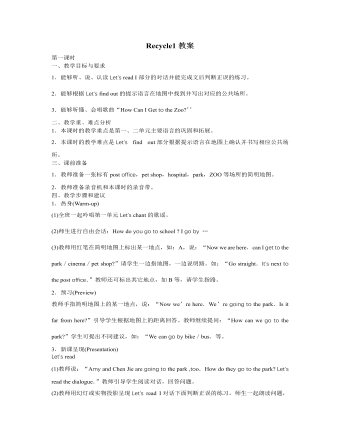
人教版新课标PEP小学英语六年级上册Recycle1教案
1.热身(warm-up) (1)全班齐唱歌曲“How call I Get to the Zoo?’’ (2)师生一起吟唱第一单元的歌谣,要求学生一边吟唱,一边用手打节拍。 2.预习(Preview) 教师对学生有关My Dream Vacation的短文做出总体评价,并请几名写得有创意的学生朗读他们的短文,教师针对其内容提问,如:“Where are you going? What are you going to do? How are you going to there等。教师根据课前的准备,在最后一名学生朗读完文章并回答了问题以后,简化并板书该学生的回答,将其改编成为一首小歌谣,如: Where are you going? What are you going to do? I’m going to the ZOO to see the monkeys. I’m going by bike.I’m going On foot. I live near the ZOO.So I won’t take a train. 教师拍节拍示范朗读自己改写的新歌谣,学生模仿吟唱新歌谣。 3.新课呈现(Presentation) Let’s chant 在以上活动的基础上,教师放Let’s chant部分的录音,学生静听并试着跟读,再看着文字吟唱。师生可进行问答式吟唱,并在小组间展开比赛。 Listen and match
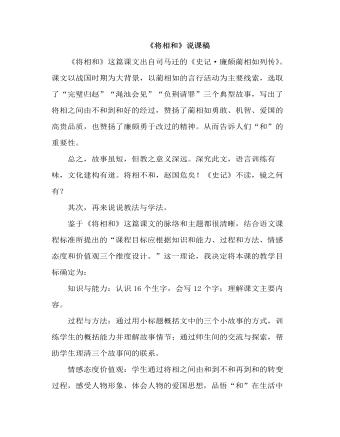
部编人教版五年级上册《将相和》说课稿
鉴于《将相和》这篇课文的脉络和主题都很清晰,结合语文课程标准所提出的“课程目标应根据知识和能力、过程和方法、情感态度和价值观三个维度设计。”这一理论,我决定将本课的教学目标确定为:知识与能力:认识16个生字,会写12个字;理解课文主要内容。过程与方法:通过用小标题概括文中的三个小故事的方式,训练学生的概括能力并理解故事情节;通过师生间的交流与探索,帮助学生理清三个故事间的联系。情感态度价值观:学生通过将相之间由和到不和再到和的转变过程,感受人物形象,体会人物的爱国思想,品悟“和”在生活中的重要性,并以此为跳板,了解中国的“和”文化。教学的重点和难点放在引导学生充分感受文中的人物形象,并且体会到“和”的意义。
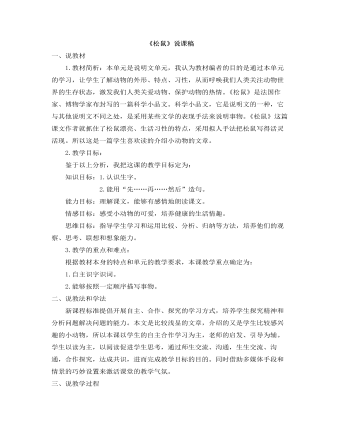
部编人教版五年级上册《 松鼠》说课稿
一、说教材 1.教材简析:本单元是说明文单元,我认为教材编者的目的是通过本单元的学习,让学生了解动物的外形、特点、习性,从而呼唤我们人类关注动物世界的生存状态,激发我们人类关爱动物、保护动物的热情。《松鼠》是法国作家、博物学家布封写的一篇科学小品文。科学小品文,它是说明文的一种,它与其他说明文不同之处,是采用某些文学的表现手法来说明事物。《松鼠》这篇课文作者就抓住了松鼠漂亮、生活习性的特点,采用拟人手法把松鼠写得活灵活现。所以这是一篇学生喜欢读的介绍小动物的文章。2.教学目标:鉴于以上分析,我把这课的教学目标定为:知识目标:1.认识生字。2.能用“先……再……然后”造句。能力目标:理解课文,能够有感情地朗读课文。情感目标:感受小动物的可爱,培养健康的生活情趣。
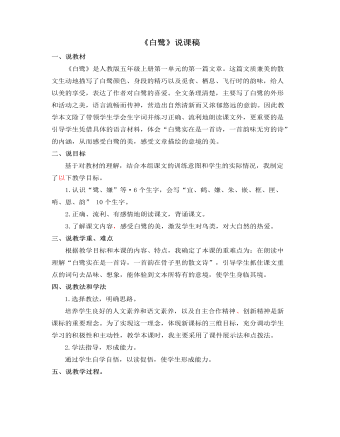
部编人教版五年级上册《白鹭》说课稿
一、说教材《白鹭》是人教版五年级上册第一单元的第一篇文章。这篇文质兼美的散文生动地描写了白鹭颜色、身段的精巧以及觅食、栖息、飞行时的韵味,给人以美的享受,表达了作者对白鹭的喜爱。全文条理清楚,主要写了白鹭的外形和活动之美,语言流畅而传神,营造出自然清新而又浓郁悠远的意韵。因此教学本文除了带领学生学会生字词并练习正确、流利地朗读课文外,更重要的是引导学生凭借具体的语言材料,体会“白鹭实在是一首诗,一首韵味无穷的诗”的内涵,从而感受白鹭的美,感受文章描绘的意境的美。二、说目标基于对教材的理解,结合本组课文的训练意图和学生的实际情况,我制定了以下教学目标。
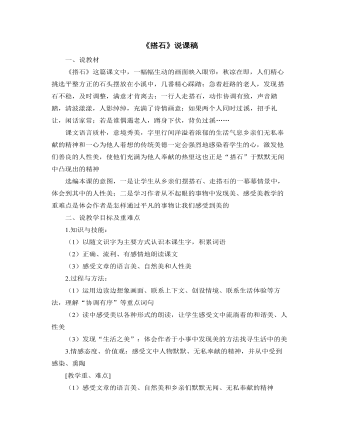
部编人教版五年级上册《搭石》说课稿
一、说教材《搭石》这篇课文中,一幅幅生动的画面映入眼帘:秋凉在即,人们精心挑选平整方正的石头摆放在小溪中,几番精心踩踏;急着赶路的老人,发现搭石不稳,及时调整,满意才肯离去;一行人走搭石,动作协调有致,声音踏踏,清波漾漾,人影绰绰,充满了诗情画意;如果两个人同时过溪,招手礼让,闲话家常;若是谁偶遇老人,蹲身下伏,背负过溪……课文语言质朴,意境秀美,字里行间洋溢着浓郁的生活气息乡亲们无私奉献的精神和一心为他人着想的传统美德一定会强烈地感染着学生的心,激发他们善良的人性美,使他们充满为他人奉献的热望这也正是“搭石”于默默无闻中凸现出的精神
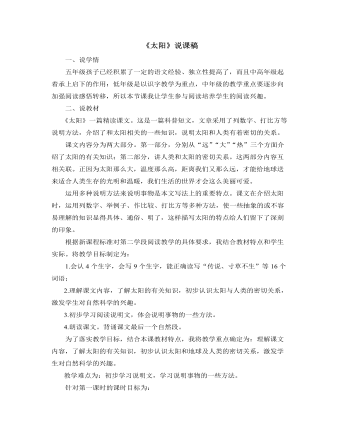
部编人教版五年级上册《太阳》说课稿
三、 说教法这是一篇说明文,它不是借助艺术形象传授知识的,而是在观察某些事物的基础上用准确、通俗的语言来说明事物传授知识的。所以我侧重以下几个方面来教的:1.抓住说明文的构段特点进行教学。教给学生学习方法,找出说明文在结构上注重一段一意,段首概括的规律,注重帮助学生理清文章的结构层次。2.抓住文中的语言,了解说明事物的方法。课文第一自然段为了讲清楚太阳的三个特点,运用了大量的数字来说明,给学生的感觉一目了然。但是为什么要引用传说,就是为了增加文章的生动性,这样教学既使学生了解了学法,又激发了学生学习兴趣。这样做的目的是,既教了课文,又学会了作者的写作方法。3.利用多媒体手段,激发学生的学习兴趣。说明文同记叙文相比,语言比较枯燥,形象性不强。在教学过程中,我制作了课件,变抽象为具体,激发学生主动学习的积极性,调动学生多种感官去接受知识,从而增强学习效果,是一举多得的方法。
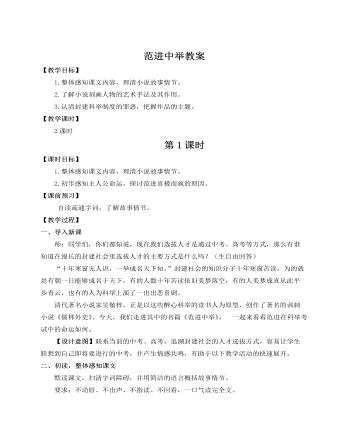
人教部编版语文九年级上册范进中举教案
3.归纳主旨本文通过描写范进参加乡试中了举人一事,运用夸张的手法刻画了他为科举考试喜极而疯的形象,用岳丈在范进中举前后的极其鲜明的肢体动作和言语表情,以及中举后邻居对他的前呼后拥和乡绅赠屋等行为,刻画了一个趋炎附势、热衷仕途、好官名利禄的封建知识分子形象,并且谴责了世态炎凉的可耻的社会风气,对当时的社会及其阴暗面进行了辛辣的讽刺。【设计意图】本板块研读品析了文本中的若干次要人物,引导学生理解次要人物的作用,体会本文侧面烘托的写法,揭示社会环境,点明范进悲剧的必然性,进一步挖掘本文的主旨,使学生理解文本深刻的现实意义。结束语:范进,一个让人啼笑皆非的人物,他卑微可怜,热衷科举,丑态百出。文章塑造这个下层知识分子的典型形象,深刻揭露并辛辣地讽刺了封建科举制度,揭露了封建科举制度的腐朽及其对读书人的腐蚀和毒害。如今,科举制度早已被废除,我们有着公平的人才选拔方式,希望同学们可以珍惜每一个机会,好好努力,实现自己的理想抱负。【板书设计】
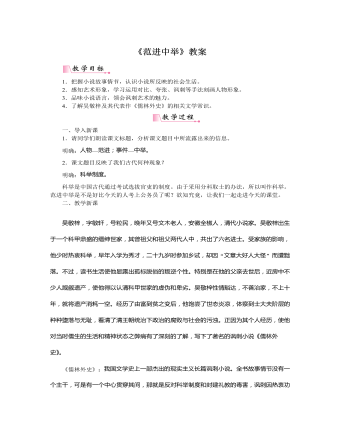
部编版语文九年级上册《范进中举》教案
目标导学一:了解作者,了解作品吴敬梓,字敏轩,号粒民,晚年又号文木老人,安徽全椒人,清代小说家。吴敬梓出生于一个科甲鼎盛的缙绅世家,其曾祖父和祖父两代人中,共出了六名进士。受家族的影响,他少时热衷科举,早年入学为秀才,二十九岁时参加乡试,却因“文章大好人大怪”而遭黜落。不过,读书生活使他显露出孤标脱俗的叛逆个性。特别是在他的父亲去世后,近房中不少人觊觎遗产,使他得以认清科甲世家的虚伪和卑劣。吴敬梓性情豁达,不善治家,不上十年,就将遗产消耗一空。经历了由富到贫之变后,他饱尝了世态炎凉,体察到士大夫阶层的种种堕落与无耻,看清了清王朝统治下政治的腐败与社会的污浊。正因为其个人经历,使他对当时儒生的生活和精神状态之弊病有了深刻的了解,写下了著名的讽刺小说《儒林外史》。

人教版新目标初中英语八年级下册What were you doing when the UFO arrived教案2篇
(一).知识方面: 1.培养学生能运用过去进行时来描述、谈论过去某个时间正在发生的事情或动作的意识和能力,能就过去某个时间正在发生的动作做出正确的描述。 2.培养学生的想象力和角色扮演的合作能力。 3.培养学生讲述过去发生的事情经过的能力。能正确运用一般过去时来讲述故事。 (二).技能方面: 1.本单元的语言目标是Talk about past events and tell a story(谈论过去的时间和讲述一个故事),围绕这一目标,要涉及句型: What were you doing when the UFO arrived? ----I was sitting in the barber’s chair. The barber was cutting my hair. 因此必须学习standing、studying、cleaning、sleeping、cooking、making、eating、cutting、等表示地点的词,以便为上述句型提供语言材料。2.学习过去进行时的有关知识。Was/were+现在分词,是该时态的表达式。 3.在学习过程中,要区分The boy was walking down the street when the UFO landed.和While the boy was walking down the street, the UFO landed.这两种由when和while引导的状语从句的句型结构。注意它们的不同。

人教版新目标初中英语八年级下册Why don’t you get her a scarf教案
教师带领学生复习有关描述宠物的词汇,采用教师提问学生回答的方进行。如:T:What animals do you think would be good pets?What animals do you think would be bad pets?What do you think are good animals for a six-year-old child?然后学生进行 pairwork 练习。Task two: 师生互动,学习探究 1、播放3a部分的录音,引导学生一边听录音,一边跟读。2、通过听录音学生回答以下问题:Why do you think pot-bellied pigs are popular?What are the advantages and disadvantages of keeping such a pet?教师对学生的回答进行及时点评。3.学习范文,学习重点短语,为下步的模仿写作提供语言素材。T :1. )Have you ever kept a pig as a pet?Do you like pigs? St.:No.…Why don’t you like to keep a pig? St: No.They’re too dirty and lazy(Do you know in some foreign countries like Hollyland, Australia,pigs are the most popular pet.there’s a kind of pig.(图)it has an interesting name? it ‘s called a pot-bellied pig.) Now,let’s learn an article about this kind of interesting pet.2.)play the tapeSt.:Listen and repeat3.)show some Qs on computer(本子St.: read silently,then answerthe Qs(本子)4.)Ask ss. Close book and retell this passage.(what is a pot-bellied pig? Is it a good or bad pet? ) St.: retell it to each other“A pot –bellied pig is a popular pet now…”5.read the article together.St.:.practice reading

人教版新目标初中英语八年级下册Have you ever been to an amusement park教案
(1)Have you ever been to …? Yes, I have. / Yes, I have ever been to …No, I haven’t. / No, I have never been to …(2)When did you go there? I went there last year. (3)I have never been to a water park. Neither have I. I have ever been to an amusement park. So have I. (4)How long have you been studying English? I’ve been studying English since nine o’clock. I’ve been studying English since I came back home. I’ve been studying English for five hours. (5)What’s that? It’s an amusement park in Japan. I’ve never been to an amusement park like it before. It’s fun to learn another language. Let’s go tonight. Isn’t this great?space museum, amusement park, water park, South America, Peru, Holland, European culture, tour guide, flight attendant, musical instrument, more than, be from, get to, take lessons, neither, discover, graduate, change

人教版新目标初中英语八年级下册What should I do教案2篇
说明:在帮Li Lei提建议的同时,教育学生如何学好英语。第三课时教学目标1. 语言目标:a) 词汇: Original, in style, haircut, the same as.b) 语言结构:My friend wears the same clothes and has the same haircut as I do.2. 能力目标:大多数学生能够谈论自己喜欢哪种服装,提高查找信息的能力。3. 情感目标:学会如何与朋友相处,要有自己对时尚的看法。教学重点掌握一些重要词汇。教学难点学会谈论问题,并能提出书面建议。◆教学突破首先针对Erin的问题,提出个人的建议,模仿2c部分的对话展开双人交际Pair-work;听老师诵读3a部分的信件,并找出LEFT OUT的问题所在;学生完成3b部分的内容,给Left Out提出书面的建议;学以口头形式提出自己目前存在的某个问题,讲给大家听,让同学们给自己提出一个建议,并作笔录;学生两、三个人分成一组,随意性地进行口语交际,谈论P14的第4部分的某个问题,相互交换意见。

人教版新目标初中英语八年级下册If you go to the party, you’ll have a great time教案2篇
区分宾语从句、定于从句和状语从句宾语从句和状语从句,都叫做主从复合句。宾语从句主要是中考必考的,是初中阶段必掌握的从句,宾语从句主要是掌握三要素,所谓宾语从句,就是宾语在主从复合句当中充当宾语的一个句子,叫做宾语从句。主句的谓语动词是及物动词,后面如果是词或者是短语的话,是简单句,如果是句子的话,肯定是宾语从句。I know that he good at English.就是宾语从句,三要素,一要素是要注意连词,连词一共学了三类连词,一类连词是that口语当中可以省略,就像刚才说的那一句,I hear he is good at English.还有疑问代词、疑问副词,how where when,疑问代词、疑问副词。还有一类连词weather是否的意思,不是状语从句当中的如果,这一定要和如果区分开,这是是否。I don't know if he interested at English。宾语从句要注意if是连词。第二要素是语序,要用陈述举语序。比如说你家有几口人,我们都说How many people are there in you family?但是这是简单句,一旦说成宾语从句,你可以告诉我你家有几口人吗?Could you tell me how many people there are in you family ?

人教版新目标初中英语八年级下册It’s a nice day, isn’t it教案2篇
"Hello! Welcome to English class! Introduce yourself. Meet your new classmates." That's what the teacher says. What do you say? "Oh no!" It can be difficult talking to new people. But it can be fun, and you can make friends. How do you do it? Make small talk. Small talk is polite conversation. "Wang Nan is a great pingpang player, isn't she?" "I'd love to meet her, wouldn't you?" "It's been raining a lot, hasn't it?" Tag questions are a form of polite speech. To make small talk successfully, you should know how to make them. You should also know what topics to talk about. Try to learn this unit carefully. The next time you're in English class, you'll find out. Making small talk's easy, isn't it? (“你好!欢迎你!请做一下自我介绍。认识一下你的新同学。”通常在课上老师会这样说。你会说什么呢?“噢,不!”与陌生人谈话太困难了。但是这也很有意思,并且你还能交到朋友。你该怎么做呢?闲聊。闲聊指得是礼貌的对话。“王楠是一个很棒的乒乓球运动员,不是吗?”“我希望自己能认识她,你呢?“今年的雨水很多,不是吗?”反意疑问句是一种礼貌用语。为了使得谈话成功,你应该知道怎样去进行闲聊。你还应该知道与不同的人该谈论什么样的话题。认真的学习这个单元吧,下次在英语课上,你会发现与大家展开谈话是一件很容易的事情,不信我们来试试。)

人教版新目标初中英语八年级下册He said I was hard-working教案2篇
This activity introduces some new vocabulary and provide oral practice using the target language.Task 1 . Ask four students to stand in front of the class, and the teacher asks them the following questions as a reporter.1.What are you going to do when you grow up?2.What are you going to do next week?3.What are going to do after school?The students will give different answers, then ask a good student to report what they said.I am going to e a doctor.What did she say?----------She said she was going to be a doctor.I am going to have a party on Friday night.What did he say?-------He said he was going to have a party on Friday night.I am going to do my homework.What did she say ?------ She said she was going to do her homework.I am going home after school.What did she say?-----She said she was going home after school.Say In this unit we are going to learn to use words like to report what someone said.Task 2. Read the instructions. Then ask a student to read the four questions. And write the words on the Bb. Explain what soap opera is.Task 3. Ask the students to Look at the pictures, point out the TV screens in the picture. Ask one girl to read what Marcia said.What did Marcia say? She said She said she was having a surprise party for Lana on Friday night. Repeat the other pictures in the same way.Activity3. Listen and number the pictures in activity 1a.

人教版新目标初中英语八年级下册How long have you been collecting shells教案2篇
Step Ⅱ Show the new words on the screen and teach the new words. Read the new words to students and ask them to repeat.Step Ⅲ 3aThis activity introduces new vocabulary and provides reading practice using the target language.In this activity first look at the four pictures.T: What can you see in the pictures?Ss: Four snow globes.T: Right. There are four snow globes in the pictures. And what are they?Ss: They are a monster, two polar bears, two penguins and a birthday cake.Write these words on the blackboard: snow globe; monster; polar bear; penguin and birthday cake. Read them to the class and ask students to repeat each one. Make sure students understand each word.Use a computer to show the E-mail message on the screen and read the message to students.Get students to read the e-mail on their own, and then draw lines connecting each snow globe and its description.Correct the answers.AnswersA line should connect each snow globe picture with the words that describe it in the letter.Step Ⅳ 3bThis activity provides writing practice using the target language.First review Activity 2a on Page 47.Then ask students to complete the message according to Activity 2a.Some partial sentences are given to students. Write about one person's collection.When students work, walk around the room checking the progress and offering help as needed.When they finish, ask some students to read their messages to the class.

人教版新目标初中英语八年级下册Would you mind turning down the music教案
Step 4. Group work (4)1. Ask a pair of students to read the dialogue. Say, This activity provides speaking, listening and writing practice using the target language.2. Ask students to complete the work in groups.3. Check the answers with the whole class. 4. Explain some of the language points. Step 5. Word review (Self check 1)1. Ask students to read the words and the phrases given. 2. Fill in the blanks with proper forms of these words to complete the sentences. 3. Check the answers with the whole class. Homework:Do activity 2 on page 57 after class. Period 6Teaching aims: 1. Teach vocabulary words and the useful expressions. 2. Enable the students to learn etiquette in different culture. 3. Help the students learn how to behave politely in public places and in daily life. Teaching procedures:Step 1. RevisionHelp students to review the function of making requests through a free talk. Then lead them to the topic of etiquette. Explain the meaning of etiquette. Or, ask students to look it up in the dictionary. Step 2. Pre-reading (Section 1)1. Ask students to read the picture and make a list with their partner about how many rules of etiquette can be seen being broken.
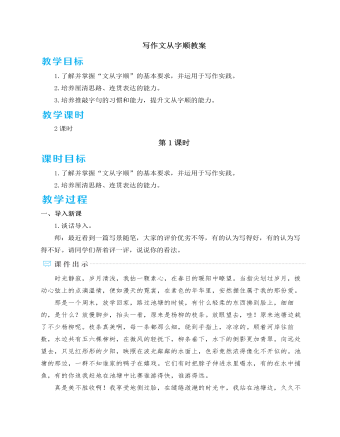
人教部编版七年级下册写作文从字顺教案
二、升格训练师:大文豪曹雪芹写《红楼梦》是“披阅十载,增删五次”,可见修改是写作获得成功的必然环节,很多文学名家对此也深有感触。这些古今中外的作家,都向我们推荐了一种修改文章的好方法——朗读修改法。结合你自己的写作经验,你觉得大声朗读可以发现习作中的哪些问题?预设 如有些词语听起来不顺耳,有些句子读起来不顺口,有些段落缺少过渡,或前后意思重复,有些地方表达不清楚,有些修辞手法的运用欠妥,有些标点的运用不规范等,这些问题都能够在朗读中发现。2.再改随笔。师:之前修改写景随笔,用的是默读修改法,这次换作朗读修改法,会不会有新的收获呢?请大家朗读病文,然后小组讨论:文中还有哪些用词不恰当、语句不连贯的地方,找出来并进行修改,使之文从字顺。(生朗读随笔,修改后交流讨论并展示)预设 (1)“有什么轻柔的东西拂到脸上,细细的”,可以把“轻柔的”改成叠词“柔柔的”,放到后面,和“细细的”并列,这样读起来音律感要好些。
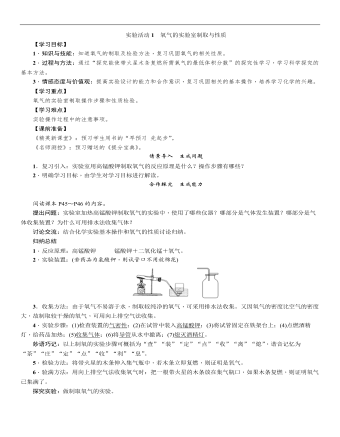
初中化学人教版九年级上册《实验活动1氧气的实验室制取与性质》教案
【学习目标】1.知识与技能:知道氧气的制取及检验方法,复习巩固氧气的相关性质。2.过程与方法:通过“探究能使带火星木条复燃所需氧气的最低体积分数”的探究性学习,学习科学探究的基本方法。3.情感态度与价值观:提高实验设计的能力和合作意识,复习巩固相关的基本操作,培养学习化学的兴趣。【学习重点】氧气的实验室制取操作步骤和性质检验。【学习难点】实验操作过程中的注意事项。【课前准备】《精英新课堂》:预习学生用书的“早预习先起步”。《名师测控》:预习赠送的《提分宝典》。情景导入 生成问题1.复习引入:实验室用高锰酸钾制取氧气的反应原理是什么?操作步骤有哪些?2.明确学习目标,由学生对学习目标进行解读。合作探究 生成能力阅读课本P45~P46的内容。提出问题:实验室加热高锰酸钾制取氧气的实验中,使用了哪些仪器?哪部分是气体发生装置?哪部分是气体收集装置?为什么可用排水法收集气体?讨论交流:结合化学实验基本操作和氧气的性质讨论归纳。

